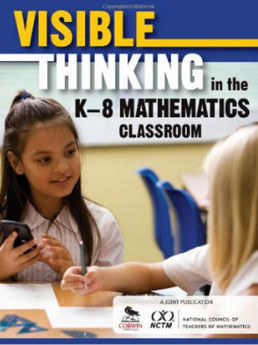Visible Thinking in the K-8 Mathematics Classroom
Ted H. Hull, Don S. Balka & Ruth Harbin Miles
Review by: Jisoo Seo
In Visible Thinking in the K-8 Mathematics Classroom (2011), Hull, Balka, and Harbin Miles share the insights they gained as mathematics teachers, as well as pre-service and in-service teacher educators. They build on the teacher audiences’ current level of understanding and performances to offer them a sequential and developmental plan to promoting visible thinking in mathematics classrooms. The book contains an excellent overview of (a) what visible thinking is—a “conscious, [intentional], and deliberate set of actions that provides clear evidence of the current level of student knowledge and understanding”; (b) why it is important—to take students to a deeper level of understanding; and (c) how it can be integrated into current classroom practices—deliberate and intentional lessons that promote problem solving unique situations, allow students the time to think, reason and struggle, and stimulate visible thinking through discussions.
This book is teacher-friendly with numerous examples of how traditional questions that require minimal thinking can be adapted into alternative problems that foster visible thinking. The classroom scenarios are also a practical feature of this book. These student-teacher dialogues show successful teacher interventions and how visible thinking might manifest itself in math classrooms. Although Part III of the book is devoted to showing how such instructional model can be implemented at different grade levels, readers could have benefitted from more specific strategies in different curriculum strands, and comprehensive guidelines for assessment of visible thinking. Furthermore, the book should have delved deeper into how teachers can create this “open- and safe-environment” that the authors advocate so strongly.
Although the examples of alternative problems and visible thinking scenarios have implications in Canadian classrooms, the book only makes explicit references to the US curriculum, which is no surprise given that the book was based in the USA as a joint publication of National Council of Teachers of Mathematics (NCTM). I believe that a Canadian Edition of Visible Thinking would have a strong influence on Canadian teachers. But for this to happen, the book needs to offer detailed strategies on how teachers can balance all the different subject and content areas with this need for time—the time students need to “think, reason, and struggle”.

